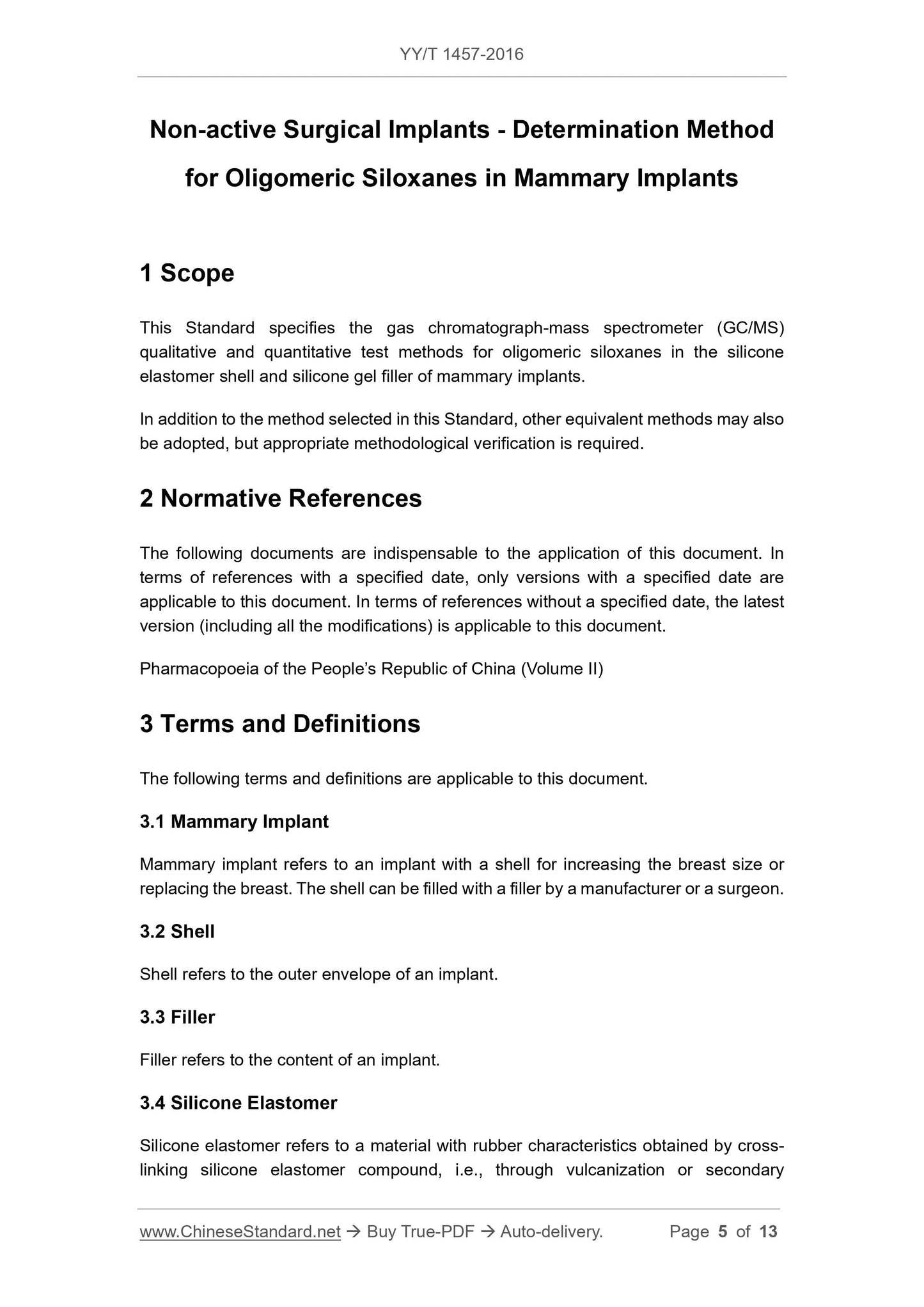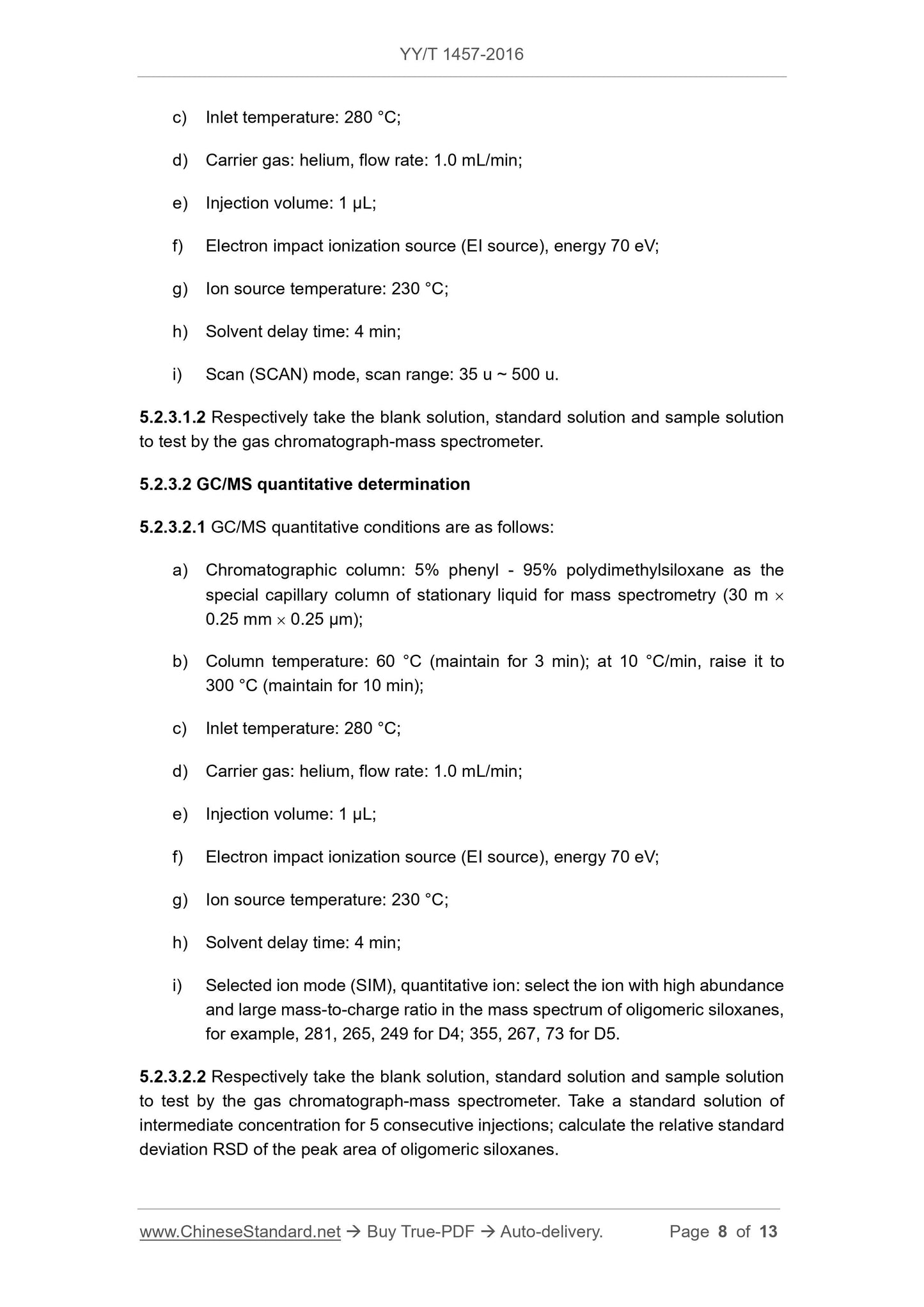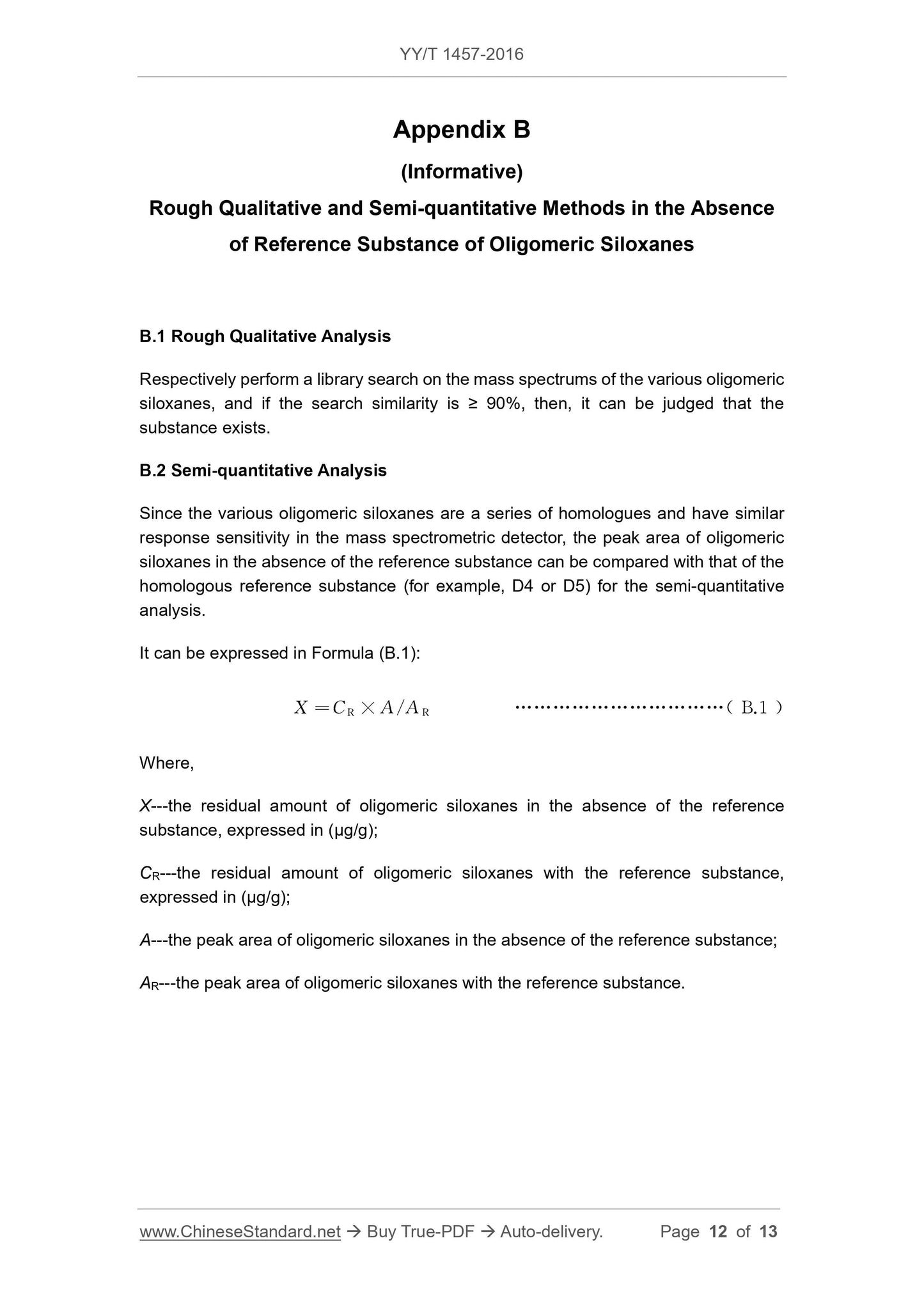1
/
の
6
PayPal, credit cards. Download editable-PDF & invoice in 1 second!
YY/T 1457-2016 English PDF (YYT1457-2016)
YY/T 1457-2016 English PDF (YYT1457-2016)
通常価格
$170.00 USD
通常価格
セール価格
$170.00 USD
単価
/
あたり
配送料はチェックアウト時に計算されます。
受取状況を読み込めませんでした
Delivery: 3 seconds. Download true-PDF + Invoice.
Get QUOTATION in 1-minute: Click YY/T 1457-2016
Historical versions: YY/T 1457-2016
Preview True-PDF (Reload/Scroll if blank)
YY/T 1457-2016: Non-active surgical implants--Determination method for oligomeric siloxanes in mammary implants
YY/T 1457-2016
YY
PHARMACEUTICAL INDUSTRY STANDARD
OF THE PEOPLE’S REPUBLIC OF CHINA
ICS 11.040.40
C 45
Non-active Surgical Implants - Determination Method
for Oligomeric Siloxanes in Mammary Implants
ISSUED ON: JANUARY 26, 2016
IMPLEMENTED ON: JANUARY 1, 2017
Issued by: China Food and Drug Administration
Table of Contents
Foreword ... 3
Introduction ... 4
1 Scope ... 5
2 Normative References ... 5
3 Terms and Definitions ... 5
4 Samples, Reagents and Apparatuses ... 6
5 Test Process ... 6
6 Result Analysis ... 9
Appendix A (Informative) Examples of Spectrums ... 11
Appendix B (Informative) Rough Qualitative and Semi-quantitative Methods in
the Absence of Reference Substance of Oligomeric Siloxanes ... 12
Bibliography ... 13
Non-active Surgical Implants - Determination Method
for Oligomeric Siloxanes in Mammary Implants
1 Scope
This Standard specifies the gas chromatograph-mass spectrometer (GC/MS)
qualitative and quantitative test methods for oligomeric siloxanes in the silicone
elastomer shell and silicone gel filler of mammary implants.
In addition to the method selected in this Standard, other equivalent methods may also
be adopted, but appropriate methodological verification is required.
2 Normative References
The following documents are indispensable to the application of this document. In
terms of references with a specified date, only versions with a specified date are
applicable to this document. In terms of references without a specified date, the latest
version (including all the modifications) is applicable to this document.
Pharmacopoeia of the People’s Republic of China (Volume II)
3 Terms and Definitions
The following terms and definitions are applicable to this document.
3.1 Mammary Implant
Mammary implant refers to an implant with a shell for increasing the breast size or
replacing the breast. The shell can be filled with a filler by a manufacturer or a surgeon.
3.2 Shell
Shell refers to the outer envelope of an implant.
3.3 Filler
Filler refers to the content of an implant.
3.4 Silicone Elastomer
Silicone elastomer refers to a material with rubber characteristics obtained by cross-
linking silicone elastomer compound, i.e., through vulcanization or secondary
spectrometer (GC/MS) for the qualitative and quantitative determination of the extracts.
The extracts are mainly oligomeric siloxanes, such as: octamethylcyclotetrasiloxane
(D4), decamethylcyclopentasiloxane (D5) and dodecamethylcyclohexasiloxane (D6),
etc.
5.2 Test Procedures
5.2.1 Preparation of test solutions
5.2.1.1 Preparation of silicone elastomer test solution
Weigh-take an appropriate amount of the silicone elastomer shell material; cut it into
small pieces of about 1 cm2. In accordance with the proportion of 1 g of sample added
with 5 mL of acetone, add acetone; seal it. At room temperature, at the frequency of
40 kHz, conduct ultrasonic for 30 min. For the liquid part, use 0.45 μm organic filter
membrane to filter it, then, obtain the test solution.
In the same way, prepare the blank control solution.
5.2.1.2 Preparation of silicone gel test solution
Weigh-take an appropriate amount of the silicone gel material. In accordance with the
proportion of 1 g of sample added with 5 mL of acetone, add acetone; seal it. At room
temperature, at the frequency of 40 kHz, conduct ultrasonic for 30 min. For the liquid
part, use 0.45 μm organic filter membrane to filter it, then, obtain the test solution.
In the same way, prepare the blank control solution.
5.2.2 Preparation of standard solution
Respectively take 0.05 g of D4 and D5 oligomeric siloxanes, accurately weigh them.
Use acetone to reach a constant volume of 50 mL. Successively use acetone to dilute
the solution and prepare a mixed standard solution of D4 and D5 oligomeric siloxanes
with at least 5 concentration gradients and with a concentration of 1 μg/mL ~ 50 μg/mL.
5.2.3 GC/MS determination
5.2.3.1 GC/MS qualitative determination
5.2.3.1.1 GC/MS qualitative conditions are as follows:
a) Chromatographic column: 5% phenyl - 95% polydimethylsiloxane as the
special capillary column of stationary liquid for mass spectrometry (30 m
0.25 mm 0.25 μm);
b) Column temperature: 60 °C (maintain for 3 min); at 10 °C/min, raise it to
300 °C (maintain for 10 min);
c) Inlet temperature: 280 °C;
d) Carrier gas: helium, flow rate: 1.0 mL/min;
e) Injection volume: 1 μL;
f) Electron impact ionization source (EI source), energy 70 eV;
g) Ion source temperature: 230 °C;
h) Solvent delay time: 4 min;
i) Scan (SCAN) mode, scan range: 35 u ~ 500 u.
5.2.3.1.2 Respectively take the blank solution, standard solution and sample solution
to test by the gas chromatograph-mass spectrometer.
5.2.3.2 GC/MS quantitative determination
5.2.3.2.1 GC/MS quantitative conditions are as follows:
a) Chromatographic column: 5% phenyl - 95% polydimethylsiloxane as the
special capillary column of stationary liquid for mass spectrometry (30 m
0.25 mm 0.25 μm);
b) Column temperature: 60 °C (maintain for 3 min); at 10 °C/min, raise it to
300 °C (maintain for 10 min);
c) Inlet temperature: 280 °C;
d) Carrier gas: helium, flow rate: 1.0 mL/min;
e) Injection volume: 1 μL;
f) Electron impact ionization source (EI source), energy 70 eV;
g) Ion source temperature: 230 °C;
h) Solvent delay time: 4 min;
i) Selected ion mode (SIM), quantitative ion: select the ion with high abundance
and large mass-to-charge ratio in the mass spectrum of oligomeric siloxanes,
for example, 281, 265, 249 for D4; 355, 267, 73 for D5.
5.2.3.2.2 Respectively take the blank solution, standard solution and sample solution
to test by the gas chromatograph-mass spectrometer. Take a standard solution of
intermediate concentration for 5 consecutive injections; calculate the relative standard
deviation RSD of the peak area of oligomeric siloxanes.
Appendix B
(Informative)
Rough Qualitative and Semi-quantitative Methods in the Absence
of Reference Substance of Oligomeric Siloxanes
B.1 Rough Qualitative Analysis
Respectively perform a library search on the mass spectrums of the various oligomeric
siloxanes, and if the search similarity is ≥ 90%, then, it can be judged that the
substance exists.
B.2 Semi-quantitative Analysis
Since the various oligomeric siloxanes are a series of homologues and have similar
response sensitivity in the mass spectrometric detector, the peak area of oligomeric
siloxanes in the absence of the reference substance can be compared with that of the
homologous reference substance (for example, D4 or D5) for the semi-quantitative
analysis.
It can be expressed in Formula (B.1):
Where,
X---the residual amount of oligomeric siloxanes in the absence of the reference
substance, expressed in (μg/g);
CR---the residual amount of oligomeric siloxanes with the reference substance,
expressed in (μg/g);
A---the peak area of oligomeric siloxanes in the absence of the reference substance;
AR---the peak area of oligomeric siloxanes with the reference substance.
Get QUOTATION in 1-minute: Click YY/T 1457-2016
Historical versions: YY/T 1457-2016
Preview True-PDF (Reload/Scroll if blank)
YY/T 1457-2016: Non-active surgical implants--Determination method for oligomeric siloxanes in mammary implants
YY/T 1457-2016
YY
PHARMACEUTICAL INDUSTRY STANDARD
OF THE PEOPLE’S REPUBLIC OF CHINA
ICS 11.040.40
C 45
Non-active Surgical Implants - Determination Method
for Oligomeric Siloxanes in Mammary Implants
ISSUED ON: JANUARY 26, 2016
IMPLEMENTED ON: JANUARY 1, 2017
Issued by: China Food and Drug Administration
Table of Contents
Foreword ... 3
Introduction ... 4
1 Scope ... 5
2 Normative References ... 5
3 Terms and Definitions ... 5
4 Samples, Reagents and Apparatuses ... 6
5 Test Process ... 6
6 Result Analysis ... 9
Appendix A (Informative) Examples of Spectrums ... 11
Appendix B (Informative) Rough Qualitative and Semi-quantitative Methods in
the Absence of Reference Substance of Oligomeric Siloxanes ... 12
Bibliography ... 13
Non-active Surgical Implants - Determination Method
for Oligomeric Siloxanes in Mammary Implants
1 Scope
This Standard specifies the gas chromatograph-mass spectrometer (GC/MS)
qualitative and quantitative test methods for oligomeric siloxanes in the silicone
elastomer shell and silicone gel filler of mammary implants.
In addition to the method selected in this Standard, other equivalent methods may also
be adopted, but appropriate methodological verification is required.
2 Normative References
The following documents are indispensable to the application of this document. In
terms of references with a specified date, only versions with a specified date are
applicable to this document. In terms of references without a specified date, the latest
version (including all the modifications) is applicable to this document.
Pharmacopoeia of the People’s Republic of China (Volume II)
3 Terms and Definitions
The following terms and definitions are applicable to this document.
3.1 Mammary Implant
Mammary implant refers to an implant with a shell for increasing the breast size or
replacing the breast. The shell can be filled with a filler by a manufacturer or a surgeon.
3.2 Shell
Shell refers to the outer envelope of an implant.
3.3 Filler
Filler refers to the content of an implant.
3.4 Silicone Elastomer
Silicone elastomer refers to a material with rubber characteristics obtained by cross-
linking silicone elastomer compound, i.e., through vulcanization or secondary
spectrometer (GC/MS) for the qualitative and quantitative determination of the extracts.
The extracts are mainly oligomeric siloxanes, such as: octamethylcyclotetrasiloxane
(D4), decamethylcyclopentasiloxane (D5) and dodecamethylcyclohexasiloxane (D6),
etc.
5.2 Test Procedures
5.2.1 Preparation of test solutions
5.2.1.1 Preparation of silicone elastomer test solution
Weigh-take an appropriate amount of the silicone elastomer shell material; cut it into
small pieces of about 1 cm2. In accordance with the proportion of 1 g of sample added
with 5 mL of acetone, add acetone; seal it. At room temperature, at the frequency of
40 kHz, conduct ultrasonic for 30 min. For the liquid part, use 0.45 μm organic filter
membrane to filter it, then, obtain the test solution.
In the same way, prepare the blank control solution.
5.2.1.2 Preparation of silicone gel test solution
Weigh-take an appropriate amount of the silicone gel material. In accordance with the
proportion of 1 g of sample added with 5 mL of acetone, add acetone; seal it. At room
temperature, at the frequency of 40 kHz, conduct ultrasonic for 30 min. For the liquid
part, use 0.45 μm organic filter membrane to filter it, then, obtain the test solution.
In the same way, prepare the blank control solution.
5.2.2 Preparation of standard solution
Respectively take 0.05 g of D4 and D5 oligomeric siloxanes, accurately weigh them.
Use acetone to reach a constant volume of 50 mL. Successively use acetone to dilute
the solution and prepare a mixed standard solution of D4 and D5 oligomeric siloxanes
with at least 5 concentration gradients and with a concentration of 1 μg/mL ~ 50 μg/mL.
5.2.3 GC/MS determination
5.2.3.1 GC/MS qualitative determination
5.2.3.1.1 GC/MS qualitative conditions are as follows:
a) Chromatographic column: 5% phenyl - 95% polydimethylsiloxane as the
special capillary column of stationary liquid for mass spectrometry (30 m
0.25 mm 0.25 μm);
b) Column temperature: 60 °C (maintain for 3 min); at 10 °C/min, raise it to
300 °C (maintain for 10 min);
c) Inlet temperature: 280 °C;
d) Carrier gas: helium, flow rate: 1.0 mL/min;
e) Injection volume: 1 μL;
f) Electron impact ionization source (EI source), energy 70 eV;
g) Ion source temperature: 230 °C;
h) Solvent delay time: 4 min;
i) Scan (SCAN) mode, scan range: 35 u ~ 500 u.
5.2.3.1.2 Respectively take the blank solution, standard solution and sample solution
to test by the gas chromatograph-mass spectrometer.
5.2.3.2 GC/MS quantitative determination
5.2.3.2.1 GC/MS quantitative conditions are as follows:
a) Chromatographic column: 5% phenyl - 95% polydimethylsiloxane as the
special capillary column of stationary liquid for mass spectrometry (30 m
0.25 mm 0.25 μm);
b) Column temperature: 60 °C (maintain for 3 min); at 10 °C/min, raise it to
300 °C (maintain for 10 min);
c) Inlet temperature: 280 °C;
d) Carrier gas: helium, flow rate: 1.0 mL/min;
e) Injection volume: 1 μL;
f) Electron impact ionization source (EI source), energy 70 eV;
g) Ion source temperature: 230 °C;
h) Solvent delay time: 4 min;
i) Selected ion mode (SIM), quantitative ion: select the ion with high abundance
and large mass-to-charge ratio in the mass spectrum of oligomeric siloxanes,
for example, 281, 265, 249 for D4; 355, 267, 73 for D5.
5.2.3.2.2 Respectively take the blank solution, standard solution and sample solution
to test by the gas chromatograph-mass spectrometer. Take a standard solution of
intermediate concentration for 5 consecutive injections; calculate the relative standard
deviation RSD of the peak area of oligomeric siloxanes.
Appendix B
(Informative)
Rough Qualitative and Semi-quantitative Methods in the Absence
of Reference Substance of Oligomeric Siloxanes
B.1 Rough Qualitative Analysis
Respectively perform a library search on the mass spectrums of the various oligomeric
siloxanes, and if the search similarity is ≥ 90%, then, it can be judged that the
substance exists.
B.2 Semi-quantitative Analysis
Since the various oligomeric siloxanes are a series of homologues and have similar
response sensitivity in the mass spectrometric detector, the peak area of oligomeric
siloxanes in the absence of the reference substance can be compared with that of the
homologous reference substance (for example, D4 or D5) for the semi-quantitative
analysis.
It can be expressed in Formula (B.1):
Where,
X---the residual amount of oligomeric siloxanes in the absence of the reference
substance, expressed in (μg/g);
CR---the residual amount of oligomeric siloxanes with the reference substance,
expressed in (μg/g);
A---the peak area of oligomeric siloxanes in the absence of the reference substance;
AR---the peak area of oligomeric siloxanes with the reference substance.
Share












